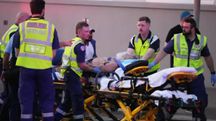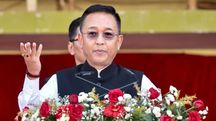Bangladesh enforces curfew and 'shoot-on-sight' orders amid protests over job quotas
A stringent curfew accompanied by a "shoot-on-sight" directive has been imposed across Bangladesh, as military forces patrol parts of the capital, Dhaka, following violent clashes over civil service job allocations. The curfew, which commenced at midnight, includes a brief relaxation period from noon to 2 p.m. to allow for essential activities.

A stringent curfew accompanied by a "shoot-on-sight" directive has been imposed across Bangladesh, as military forces patrol parts of the capital, Dhaka, following violent clashes over civil service job allocations. The curfew, which commenced at midnight, includes a brief relaxation period from noon to 2 p.m. to allow for essential activities.
It is expected to remain in effect until 10 a.m. Sunday. Under this curfew, law enforcement has been authorized to use lethal force against rioters in extreme situations, according to Obaidul Quader, the general secretary of the ruling Awami League party.
The unrest began weeks ago, driven primarily by student groups protesting against a quota system that reserves up to 30 per cent of government jobs for relatives of veterans from Bangladesh's 1971 war of independence. The protests turned violent on Tuesday, with the Daily Prothom Alo reporting at least 103 deaths. The situation worsened on Friday, deemed the deadliest day so far, with Somoy TV reporting 43 fatalities and an Associated Press correspondent witnessing 23 bodies at Dhaka Medical College and Hospital. The total death toll, including 22 reported earlier in the week, remains unclear.
The U.S. Embassy in Dhaka has indicated that the violence has resulted in "hundreds to possibly thousands" of injuries nationwide, describing the situation as "extremely volatile." Bangladeshi authorities have yet to release official figures on casualties. The government has implemented extensive measures to control the situation, including blocking online communications and restricting media coverage. Several TV channels have been taken offline, local newspaper websites are down, and some key government sites, such as those of the central bank and the prime minister’s office, have been hacked and defaced.
In addition to the unrest in urban areas, local media reports that around 800 inmates escaped from a prison in Narsingdi after protesters stormed and set fire to the facility. The current crisis underscores deep-seated issues within Bangladesh's governance and economy, reflecting widespread frustration among young people struggling with employment prospects. This turmoil poses a significant challenge to Prime Minister Sheikh Hasina, who is facing her most serious opposition since her re-election for a fourth consecutive term earlier this year.
The protesters argue that the quota system is discriminatory and unfairly benefits political allies of Hasina, who defends the system as a tribute to the veterans' contributions. In response, negotiations are underway, with representatives from both sides meeting late Friday to discuss the protesters' demands, which include reforming the quota system, reopening student dormitories, and addressing lapses in campus security. Law Minister Anisul Huq has indicated the government’s willingness to engage in dialogue.
The Bangladesh Nationalist Party (BNP), the main opposition, has expressed support for the protests and plans to organize additional demonstrations. The BNP, however, has denied accusations from the ruling party of exploiting the unrest for political leverage. The ongoing conflict between the Awami League and BNP, marked by mutual accusations of inciting violence, has been a persistent issue, especially in the lead-up to the national election marred by a crackdown on opposition figures.
In 2018, mass student protests led to the suspension of job quotas, but the High Court reinstated them in June following petitions by veterans' relatives. The Supreme Court has put this ruling on hold pending an appeal, with a decision expected on Sunday. Hasina has urged protesters to await the court's verdict before taking further action.
Copyright©2025 Living Media India Limited. For reprint rights: Syndications Today








